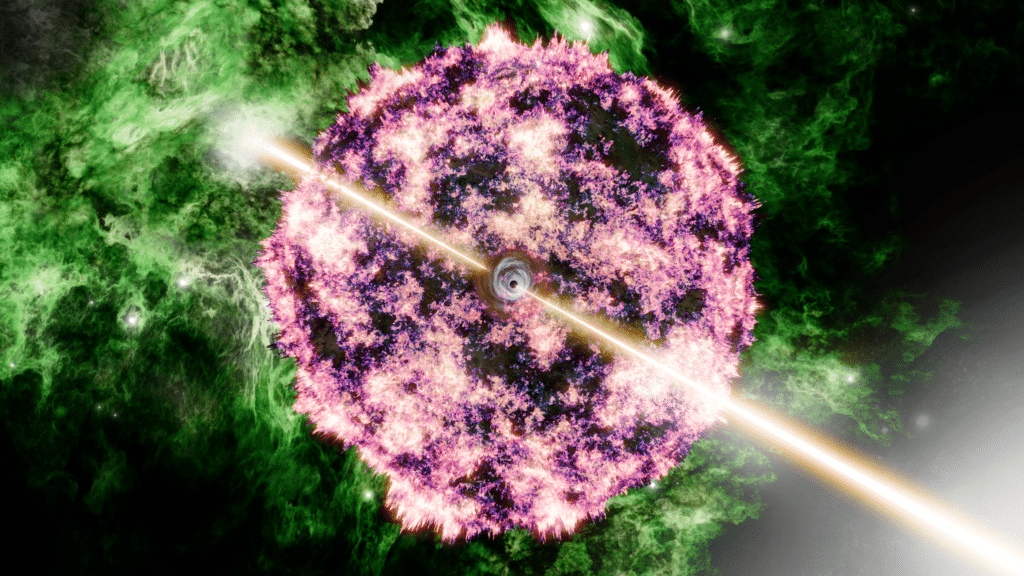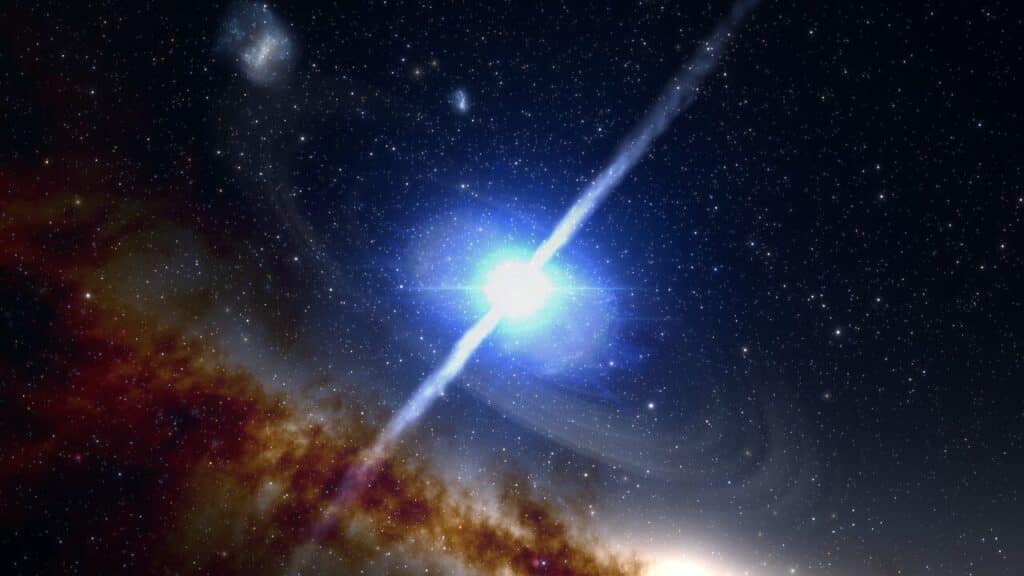The birth of the heaviest elements in the universe has long been a mystery that has captivated astronomers and stargazers alike. These elusive elements, known as r-process elements, are forged in the most extreme conditions imaginable, but the exact locations of their creation have remained a cosmic conundrum. However, the recent discovery of the brightest gamma-ray burst (GRB) ever observed, GRB 221009A, has provided a unique opportunity for astronomers to investigate one of the prime suspects in the case of the missing r-process elements: the explosive collapse of rapidly rotating massive stars. These remarkable findings are detailed in the journal Nature Astronomy.
Gamma-ray bursts are among the most energetic events in the universe, outshining entire galaxies for brief moments. These cosmic beacons are thought to arise from the collapse of massive stars into black holes, triggering a cataclysmic explosion known as a supernova. The intense conditions created in the aftermath of such an event could potentially provide the perfect breeding ground for r-process elements.
To test this theory, a team of astronomers from Northwestern University turned their gaze towards GRB 221009A using NASA’s James Webb Space Telescope (JWST), the most advanced space observatory ever built. The JWST’s unparalleled sensitivity and infrared vision allowed the researchers to peer through the veil of cosmic dust and capture the faint afterglow of the gamma-ray burst, along with the telltale signs of the accompanying supernova.
The observations, taken approximately 168 and 170 days after the initial gamma-ray trigger, revealed a surprising result. The data was well explained by a combination of a supernova similar to the famous SN 1998bw, which was associated with a previous gamma-ray burst, and a power-law afterglow. However, there was no evidence for the presence of r-process elements in the spectra.

The supernova associated with GRB 221009A, while impressive, was found to contain a modest amount of radioactive nickel, approximately 0.09 times the mass of our Sun. This is slightly less than the amount observed in SN 1998bw, indicating that the supernova accompanying this extreme gamma-ray burst was not an unusual event. This finding suggests that the mechanisms driving the gamma-ray burst and the supernova are decoupled, and that even the most energetic gamma-ray bursts are unlikely to be significant sources of r-process elements.
“When we confirmed that the GRB was generated by the collapse of a massive star, that gave us the opportunity to test a hypothesis for how some of the heaviest elements in the universe are formed,” says lead study author Peter Blanchard, astrophysicist at Northwestern, in a media release. “We did not see signatures of these heavy elements, suggesting that extremely energetic GRBs like the B.O.A.T. [brightest of all time] do not produce these elements. That doesn’t mean that all GRBs do not produce them, but it’s a key piece of information as we continue to understand where these heavy elements come from. Future observations with JWST will determine if the B.O.A.T.’s ‘normal’ cousins produce these elements.”
The search for the cosmic forges of r-process elements remains an open question, with the explosion of massive stars still being a potential candidate. However, the lack of r-process signatures in the aftermath of GRB 221009A indicates that the story may be more complex than initially thought.
Aside from the implications for r-process nucleosynthesis, the discovery of GRB 221009A has also shed light on the environmental factors that may contribute to the formation of such extreme events. The host galaxy of GRB 221009A was found to have a remarkably low metallicity, approximately 12 percent that of our Sun, making it one of the most metal-poor environments ever observed for a gamma-ray burst.
Moreover, the JWST observations revealed strong emission from molecular hydrogen (H2) at the site of the explosion, indicating recent star formation activity. This finding is particularly intriguing, as most gamma-ray burst host galaxies have been found to lack significant amounts of molecular hydrogen. The presence of H2 in the case of GRB 221009A hints at the possibility that environmental factors, such as low metallicity and ongoing star formation, may play a crucial role in the creation of these cosmic powerhouses.

“The event produced some of the highest-energy photons ever recorded by satellites designed to detect gamma rays,” explains Blanchard. “This was an event that Earth sees only once every 10,000 years. We are fortunate to live in a time when we have the technology to detect these bursts happening across the universe. It’s so exciting to observe such a rare astronomical phenomenon as the B.O.A.T. and work to understand the physics behind this exceptional event.”
The landmark observations of GRB 221009A have opened a new chapter in the study of gamma-ray bursts and their associated supernovae. While the quest to uncover the origins of r-process elements continues, this discovery has provided valuable insights into the complex interplay between the most energetic explosions in the universe and the environments in which they occur. As astronomers continue to probe the depths of the cosmos with ever-more advanced telescopes, the mysteries of the universe’s heaviest elements may soon be within our grasp.












“An artists depiction” <I sure hope you didn't pay them more than $19.99 (the monthly subscription cost for DallE) because that second picture is certainly A.i. generated, the appearance of little blocky almost pixelated like textures over the little grayish glowing ghosted out artifacst/spots/clouds scattered around the background & also the grid like texture throughout most of the image but very noticeable in the dark areas of the image where there's only stars scattered about.